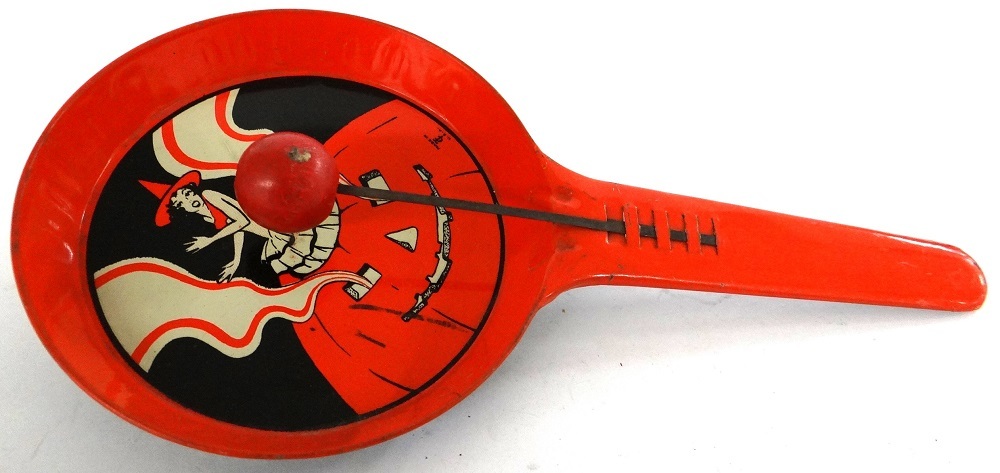
Noisemaker, Collection of Museum London, Jessie Robins, 1980.
How did Halloween, as we know it today, come to be? Read on for another informative and well-researched essay by our Curator of Regional History, Amber Lloydlangston!
With Halloween approaching, I decided to dig in the artifact collection to see what we had to mark that holiday. We have a few pieces but I chose this late 1920s or early 1930s noisemaker. To begin, I was drawn by the lithograph on this tin toy made by T. Cohn Toys, Inc. Turns out, it’s part of the long history of Halloween that I knew nothing about.
To summarize, some 2000 years ago, the Celts celebrated their New Year’s Eve, called Samhain (pronounced ‘sow-in’ with ‘sow’ sounding like ‘how’) on October 31st. On that day, the boundary between the world of the dead and the living broke down. The dead joined the living and caused a bit of mayhem unless placated with offerings of food. While troublesome, the dead could be helpful in predicting the future. To help with this, the Celts lit large fires of animal bones, or “bonefires.” They also wore animal skins and masks.
The history becomes a bit murky here. Did the Romans merge some of their festivals with those of the Celts or not? Historians don’t agree. They do agree, however, about the impact of the Catholic Church. Once the Roman Empire embraced Catholicism, the Church began to Christianize pagan festivals. This happened with Samhain beginning in the 7th century. Catholics celebrated “All Hallows Day,” the Feast of All Martyrs, on November 1st. October 31st began to be called All Hallows Eve. That, in turn, became Halloween. To mark All Hallows Eve, the Church encouraged bonfires, parades, and dressing up in costume. Sound familiar?
When large numbers of Irish and Scottish immigrants arrived in North America during the 19th century, they brought their traditions with them. One of these was marking “All Hallows Eve.” In 1919, author Ruth Edna Kelley described what happened on this …”night of ghostly and merry revelry.” She wrote, “Mischievous spirits choose it for carrying off gates and other objects, and hiding them or putting them out of reach. . . . Bags filled with flour sprinkle the passers-by. Door-bells are rung and mysterious raps sounded on doors, things thrown into halls, and knobs stolen. . . .”
This is where the noisemaker comes into the picture. Children and adolescents engaged in much of this mischievous behaviour in the early 20th century. Many adults were unimpressed, equating the children’s behaviour to “gangsterism.” To end the pranks, communities and householders began to throw Halloween parties. Costumed children received noisemakers, like the one picture here, played games, and ate treats. Some still went house to house. But they began to give householders the option of giving a treat instead of being at the receiving end of pranks.
And this is where the story becomes Canadian. The first recorded instance of children calling out “trick or treat” happened in Canada. The November 4, 1927 Lethbridge Herald reported that in nearby Blackie, Alberta, “Halloween provided an opportunity for real strenuous fun. No real damage was done except to the temper of some who had to hunt for wagon wheels, gates, wagons, barrels, etc.,…The youthful tormentors were at back door and front demanding edible plunder by the word “trick or treat” to which the inmates gladly responded and sent the robbers away rejoicing.”